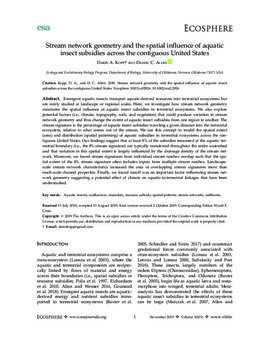| dc.contributor.author | Kopp, Darin A. | |
| dc.contributor.author | Allen, Daniel C. | |
| dc.date.accessioned | 2020-01-29T18:07:20Z | |
| dc.date.available | 2020-01-29T18:07:20Z | |
| dc.date.issued | 2019-11-06 | |
| dc.identifier.citation | Kopp, D. A., and D. C. Allen. 2019. Stream network geometry and the spatial influence of aquatic insect subsidies across the contiguous United States. Ecosphere 10(11):e02926. https://doi.org/10.1002/ecs2.2926 | en_US |
| dc.identifier.uri | https://hdl.handle.net/11244/323334 | |
| dc.description.abstract | Emergent aquatic insects transport aquatic‐derived resources into terrestrial ecosystems but are rarely studied at landscape or regional scales. Here, we investigate how stream network geometry constrains the spatial influence of aquatic insect subsidies in terrestrial ecosystems. We also explore potential factors (i.e., climate, topography, soils, and vegetation) that could produce variation in stream network geometry and thus change the extent of aquatic insect subsidies from one region to another. The stream signature is the percentage of aquatic insect subsidies traveling a given distance into the terrestrial ecosystem, relative to what comes out of the stream. We use this concept to model the spatial extent (area) and distribution (spatial patterning) of aquatic subsidies in terrestrial ecosystems across the contiguous United States. Our findings suggest that at least 8% of the subsidies measured at the aquatic–terrestrial boundary (i.e., the 8% stream signature) are typically transferred throughout the entire watershed and that variation in this spatial extent is largely influenced by the drainage density of the stream network. Moreover, we found stream signatures from individual stream reaches overlap such that the spatial extent of the 8% stream signature often includes inputs from multiple stream reaches. Landscape‐scale stream network characteristics increased the area of overlapping stream signatures more than reach‐scale channel properties. Finally, we found runoff was an important factor influencing stream network geometry suggesting a potential effect of climate on aquatic‐to‐terrestrial linkages that have been understudied. | en_US |
| dc.description.sponsorship | Financial support was provided by a grant from this National Science Foundation (EF‐1802872) to DCA, and the Adams Family Endowment at the University of Oklahoma provided additional financial support to DAK. Open Access fees paid for in whole or in part by the University of Oklahoma Libraries. | en_US |
| dc.language | en_US | en_US |
| dc.rights | Attribution 4.0 International | * |
| dc.rights.uri | https://creativecommons.org/licenses/by/4.0/ | * |
| dc.subject | aquatic insects | en_US |
| dc.subject | confluences | en_US |
| dc.subject | meanders | en_US |
| dc.subject | resource subsidy | en_US |
| dc.subject | spatial patterns | en_US |
| dc.subject | stream networks | en_US |
| dc.subject | subbasins | en_US |
| dc.title | Stream Network Geometry and the Spatial Influence of Aquatic Insect Subsidies Across the Contiguous United States | en_US |
| dc.type | Article | en_US |
| dc.description.peerreview | Yes | en_US |
| dc.identifier.doi | 10.1002/ecs2.2926 | en_US |
| ou.group | College of Arts and Sciences::Department of Biology | en_US |

